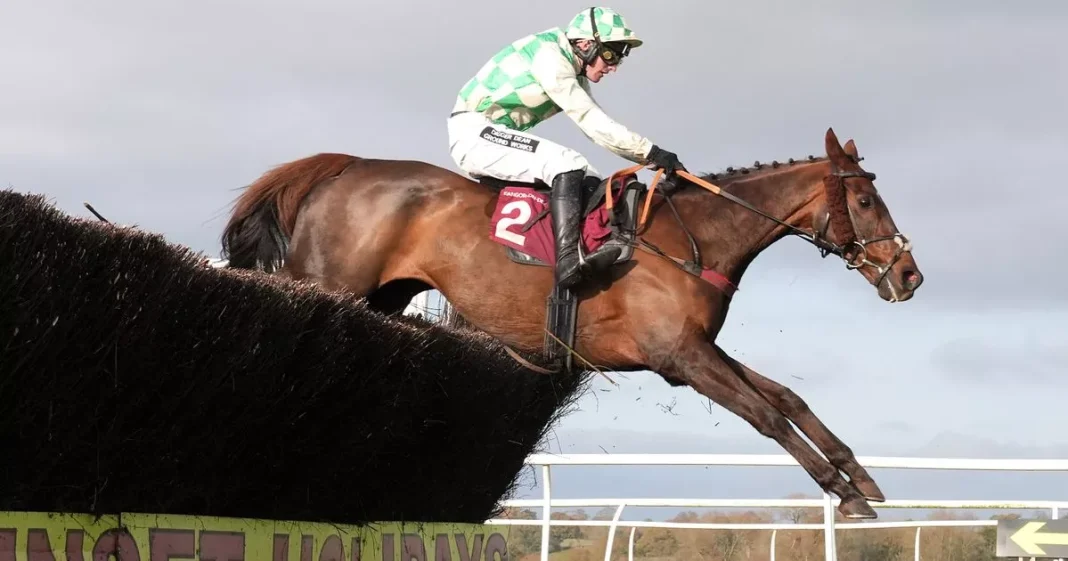The death of Celebre D’Allen, the horse who collapsed after running in the Grand National on Saturday, has sadly been announced today. The 13-year-old steed had led the field in the famous steeplechase, which was won by Nick Rockett, with three fences still to jump but he tired and went onto collapse when walked in by the veterinary team on the home straight.
Jockey Micheal Nolan was suspended for ten days after stewards held an inquiry to consider whether he had continued to race on Saturday when the horse appeared to “have no more to give”. The horse was clearly losing ground after the second last fence. Today, a statement from Celebre D’Allen’s trainers Philip Hobbs and Johnson White said: “He received the very best treatment by the veterinary teams and was improving. However, he deteriorated significantly last night and could not be saved. He was a wonderful horse and we will all miss him greatly.”
More than £2 million has been spent on horse welfare measures at Aintree in the last decade, with every animal undergoing pre-race checks from a veterinarian on limbs and joints and heart rate, plus a trot up to ensure they are fit and healthy. Each jockey is required to be passed fit and have ridden 15 winners, 10 in steeplechases, with mandatory jockey course walks with an experienced professional coach for those who have had two or less rides in Grand National races.
Celebre D’Allen’s death means 89 horses have died when competing in the famous race, which began in 1839, with 17 deaths since 2000. Horse Broadway Boy also caused concern during this year’s Grand National, with a heavy fall leading him to receive veterinary treatment on the course.
On the first day of the three-day festival, horse Willie De Houelle had suffered a fatal injury in the Boodles Anniversary 4-Y-O Juvenile Hurdle. A British Horse Racing Authority spokesperson said: “Our thoughts are with everyone connected to Willy De Houelle. All the horses taking part had passed medical checks before racing. As is the case with any fatal injury, the incident will now be looked at in detail.”
“British racing is relentless in its efforts to reduce avoidable risk,” they added. “However, as with any sport or activity involving horses it is impossible to remove risk entirely. The fatal injury rate in Jump racing is 0.44% of runners.
“At all times during a racehorse’s life, including when in training, at the racecourse or after its racing career has finished, the BHA requires that the health and well-being of the horse should be the primary consideration of those responsible for the horse’s care. The sport also has in place an independently-Chaired Horse Welfare Board which has delivered a five-year welfare strategy which has safety as a core area of focus.”
Last year, no horses died in the famous steeplechase but two horses died during the festival – Giovinco fell during the Mildmay Novice Chase and Pikar broke its neck in the Aintree Handicap Hurdle. The Jockey Club subsequently announced changes aimed to reduce the number of fallers and injuries sustained in the Grand National. These included moving the start time forward from 5.15pm to 4pm to make the ground better and reducing the number of participants from 40 to 34 to avoid the likelihood of incidents occurring.
Changes made to ensure the welfare of horses and jockeys also saw the first fence shifted 60 yards closer to the start in an attempt to ensure runners approached it at a slower pace. The start itself was made a standing start and the height of the 11th fence was lowered by two inches to 4ft 10ins. Famous fences at the race include The Chair, Becher’s Brook and Canal Turn.
Animal rights charities have long been critical of the famous race, which saw four animals lose their lives in 2023, when the start of the main race was delayed by 30 minutes when animal rights protestors attempted to access the course. Envoye Special had died on the first day at the festival and Dark Raven in a race leading up to the main event, while the famous steeplechase saw Hill Sixteen suffer a broken neck at the first fence.
A horse called Hullnback, who competed in an earlier event, died weeks after the festival due to an infection. In a statement released after the Grand National that year, speaking before Hullnback’s death, leading animal welfare charity the RSPCA said: “We urgently call on the British Horseracing Authority to review the circumstances of each of the sad deaths at Aintree, so that we never again exit a ‘festival of racing’ with three dead horses.”
The number of deaths in the main race each year from 2000-2024 are as follows:
2025 – 1
2024 – 0
2023 – 1
2022 – 2
2021 – 1
2020 – N/A
2019 – 1
2018 – 0
2017 – 0
2016 – 0
2015 – 0
2014 – 0
2013 – 0
2012 – 2
2011 – 2
2010 – 0
2009 – 1
2008 – 1
2007 – 1
2006 – 1
2005 – 0
2004 – 0
2003 – 1
2002 – 2
2001 – 0
2000 – 0
Changes made at the Grand National to improve safety include:
At Reach and across our entities we and our partners use information collected through cookies and other identifiers from your device to improve experience on our site, analyse how it is used and to show personalised advertising. You can opt out of the sale or sharing of your data, at any time clicking the “Do Not Sell or Share my Data” button at the bottom of the webpage. Please note that your preferences are browser specific. Use of our website and any of our services represents your acceptance of the use of cookies and consent to the practices described in our Privacy Notice and Cookie Notice.






